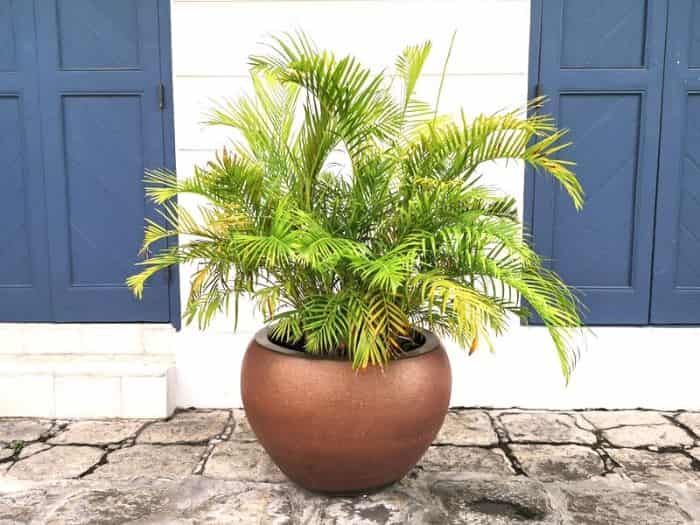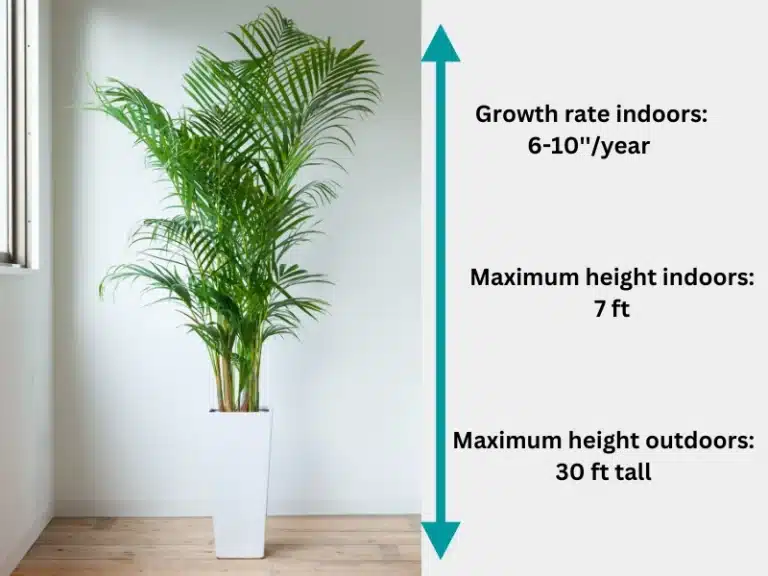Brown Tips on Areca Palm: Causes and Fixes
Brown tips on areca palms signify a stressed plant, usually from unfavorable environmental and soil conditions. Brown fronds can lead to other problems, such as stunted growth and premature leaf dropping. When not controlled, browning leaves can lead to the death of plants.
Areca palm tips and leaves turn brown due to overwatering, underwatering, nutrient deficiency, diseases, pests, and compacted roots. To fix browning leaves, water your plant regularly when the top two inches of soil are dry. Repot the plant and place it in a location with indirect sunlight. Fertilize every two months.
What causes brown tips on areca palm?

If your areca palm has started showing brown leaf tips, many reasons are causing the color change. Identifying the specific cause is essential before applying any treatment to the plant. Here are the most common reasons that cause browning leaves in the areca palm.
Underwatering
Indoor and outdoor areca palms thrive when watered regularly to maintain moist soil. In dry soils, the areca palm leaves droop and turn brown.
An underwatered areca palm cannot photosynthesize and transport nutrients to the upper plant parts. Consequently, the palm wilts, the leaf tips turn brown, and the entire palm fronds become brown over time.
Overwatering
Areca palms prefer moist, well-draining soil. When the palm is overwatered, the soil becomes soggy or overly wet, creating a conducive environment for root rot.
A plant suffering from root rot doesn’t absorb and transport water and other essential nutrients to the upper plant parts. As a result, the areca palm leaves turn brown at the tips, spreading all over the leaves.
Leaching of nutrients mostly happens to areca palms growing in the garden. Overwatering or heavy rains lead to the leaching of essential nutrients that areca palms need for growth. Leaching of nutrients beyond the fibrous root system of the palm tree deprives your areca palms of the vital nutrients for growth and can cause the browning of foliage.
Low humidity
Areca palms prefer high humidity of 50-80%. The transpiration rate increases when the humidity drops below 50%, leading to browning leaves.
Insufficient light
Areca palms thrive under the bright filtered sun in their natural habitat and thus require the same indoors.
Under low light, the areca palm leaves lack sufficient light for chlorophyll formation and photosynthesis. As a result, the palm turns its leaf tips brown. Direct sunlight also leads to browning fronds because of scorching.
Pest and diseases
Although the areca palm resists pests easily, caterpillars, mealybugs, spider mites, scales, thrips, and whiteflies might attack it. These pests commonly invade weaker palms or when the potting soil is humid.
They pierce tissues to suck the cell sap for survival. Severe pest infestation and feeding cause the browning fronds.
Palm tree diseases such as leaf spots and root rot can also cause discolored fronds. Leaf spot is commonly caused by different fungi introduced into the plant by improper watering, wind, and pets.
An areca palm suffering from leaf spots develops small brown dots which appear to have water soaked around them and later spread over the leaves. The areca palm leaves eventually turn brown and black.
Excessive fertilization
Areca palms need regular feeding for proper growth. I recommend applying fertilizer in early fall and spring when the plant is actively growing.
Proper fertilizer application involves applying the right quantities of fertilizers at the right intervals.
Whether using a homemade fertilizer or a store-bought option, applying it in excess is detrimental to the plant’s health. An overly fertilized areca palm suffers from fertilizer burn, making its leaves and tips turn brown.
Overfertilization leads to the saturation of fertilizer particles in the soil, which impedes the absorption of minerals and their transportation, leading to an unhealthy plant.
Extreme cold
Areca palms thrive in air temperatures of 65-75°F. Temperature below 50 degrees Fahrenheit makes the fronds turn black-brown.
Cold drafts too, especially in winter, cause reddish brown tips on the areca palm’s leaves.
Nutrient deficiency
Browning resulting from immobile nutrients will start showing on the new foliage. While browning resulting from mobile nutrients will start showing from the older foliage.
Some of the minerals whose deficiency will lead to browning include nitrogen, potassium, magnesium, manganese, and iron.
Lack of enough potassium either results from nutrient leaching or high nitrogen. Potassium deficiency starts showing from the older foliage and causes severe leaf necrosis.
Insufficient nitrogen in the soil leads to nitrogen chlorosis, weak trunks, and the fibrous woody tissue that forms the palm tree. This happens when there is an addition of organic materials high in carbon content to the soil.
Lack of enough iron for the plants leads to iron chlorosis. The presence of lime and high pH levels above 7.0 solidifies iron. The solid iron forms a plastic-like layer in the soil that prevents proper aeration and infiltration of water.
Reduced water infiltration leads to waterlogging that causes root rot to areca palm roots. The result is browning and dying of leaves. Iron deficiency starts showing on the new foliage.
Lack of enough manganese, magnesium, potassium, and boron also causes the browning of areca palm leaves. Lack of enough manganese in the soil reduces root activity. Boron deficiency is very chronic as it affects the new growth of leaves.
Compacted roots
Compacted roots are very dangerous to the proper growth of your indoor areca palms. Compaction weakens the root system, causes root rot, and limits the absorption and transportation of nutrients.
This leads to a slower growth rate of your areca palm and the browning of leaves. So, avoid planting your areca palms in a small plant plot.
How to fix brown leaves and tips on areca palm
You can treat the palm by identifying the cause and applying the exact remedy. Here are the ways to fix brown leaves and tips on your areca palm.
Water the plant thoroughly with water
Fix brown leaves from underwatering by watering the plant thoroughly to moisten the soil. Insert your finger or a screw into the soil to observe soil particles. A dry finger indicates dry soil. Alternatively, lift the pot and feel its weight. Underwatered pots feel lighter.
Water the plant thoroughly until excess water overflows from the drainage holes below the pot. After a good watering, check on your plant often and water it when the top two inches of soil feel dry to keep it moist.
Repot the plant
If the problem is due to overwatering, repot the plant to treat the root rot disease that’s causing leaf discoloration.
Here’s a step-by-step guide on how to repot your areca palm.
- Remove the plant from the pot and wash the root’s soil under running water.
- Trim the affected mushy brown roots using a knife or pair of scissors.
- Disinfect the scissors or knife in an alcohol-based solution.
- Clean the pot with water and sterilize it in a bleaching solution.
- Sterilize the remaining healthy roots in a fungicide solution to kill the root rot fungus.
- Add a well-draining potting mix in a planter with enough drainage holes and replant your areca palm.
- Water lightly and place the plant in indirect sunlight for fast recovery and new root growth.
Use a humidifier
Place an indoor humidifier in your room with areca palm to correct the browning leaves that result from lower humidity.
A humidifier creates a microclimate that makes it favorable for the survival of the areca palm. Additionally, bring your areca palms close to each other so they retain the air moisture around them.
However, group only healthy plants as sick ones can spread diseases.
Move the palm to a spot with indirect sunlight
You can revive an unhealthy areca palm by placing the pot in the right location. West and east-facing windows make a great spot for placing your areca planters.
If the pot is near air vents and conditioners, move it away to escape the cold draft. Also, move your areca palm pots to warmer rooms during winter.
Apply insecticidal soap or neem oil
Neem oil and insecticidal soaps treat brown fronds resulting from pests attack. Fill a spray bottle with oil or insecticidal soap and set the nozzle to spray. Carefully spray the oil on the plant parts to remove the pests.
Also, check for any small insects or pests that might be present before bringing a new plant to your house. Furthermore, seclude the plant for a few weeks before joining the rest.
Use a fungi-specific fungicide to treat leaf spots on areca palms. Remember to follow the instructions to avoid mistakes that might kill or affect your plant.
Cut down on the fertilizer
Applying less fertilizer than the recommended amount will go a long way in preventing chemical burns. Fertilize with a balanced organic fertilizer every two months when the plant is actively growing. A water-soluble fertilizer is the best.
Should I cut off brown palm leaves?
Cut off completely brown, dead palm leaves from their base. The dead fronds won’t recover, and cutting them allows new leaves to emerge. If not cut, they’ll drop off. However, if only the leaf tips are brown, don’t cut them. Adjust the conditions causing the browning tips and give the plant time to recover.
Conclusion
Browning areca leaves signify a stressed plant. Change in environmental and soil conditions causes the color change.
If your areca palm plant has its tips turning brown, carefully check for changes in humidity, temperature, light, and soil moisture and administer the right fix. When treated in time, your areca palm will recover from browning fronds and grow healthy.
References
- Clemson University: Palm Diseases and Nutritional Problems.
- The University of Florida Extension: Leaf Spot and Leaf Blight on Palms.


![Palm Tree Roots – How Deep Do They Grow? [Facts]](https://gardenine.com/wp-content/uploads/2021/03/Palm-tree-root-system-diagram.jpg)
